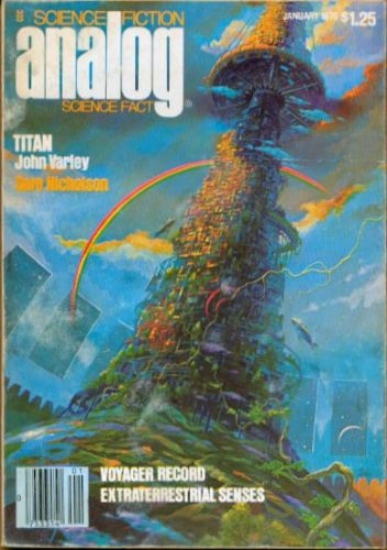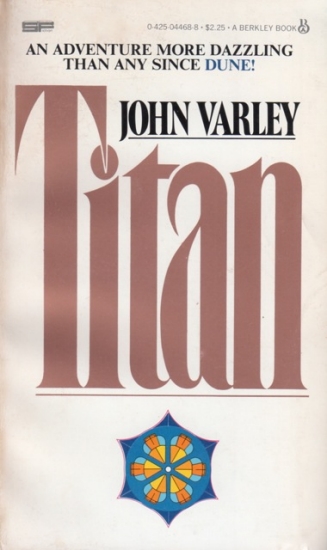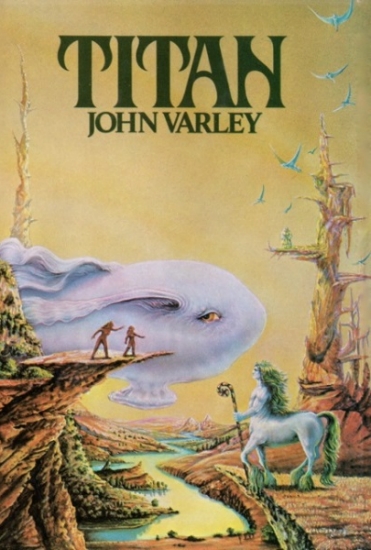The Golden Age of Science Fiction: Titan, by John Varley
The Locus Awards were established in 1972 and presented by Locus Magazine based on a poll of its readers. In more recent years, the poll has been opened up to on-line readers, although subscribers’ votes have been given extra weight. At various times the award has been presented at Westercon and, more recently, at a weekend sponsored by Locus at the Science Fiction Museum (now MoPop) in Seattle. The Best Book Publisher Award dates back to 1972, although in 1975 and 1976 the Publisher Award was split into paperback and hardcover categories. Ballantine Books won the award each year from its inception through 1977 (winning the paperback for the two experimental years with the Science Fiction Book Club winning the hardcover award). In 1978, when Del Rey was established as an imprint of Ballantine, Ballantine/Del Rey began winning the award. The award was not presented in 1979 for works published in 1978, but when it was reinstituted in 1980, Ballantine/Del Rey picked up its winning streak. In 1980. The Locus Poll received 854 responses.
Titan belongs to the subgenre of science fiction that Roz Kaveny described as “Big Dumb Objects,” or BDO, in her 1981 essay “Science Fiction in the 1970s.” As such, the novel is reminiscent of some of the earlier examples of that genre, such as Larry Niven’s Ringworld or Arthur C. Clarke’s Rendezvous with Rama. As with those earlier novels, a group of explorers, in this case human astronauts, find themselves exploring a massive artifact in space, often traveling into the interior of the world, as if they were space-faring European explorers delving into nineteenth century Africa.
In Titan, the BDO is referred to initially as Themis, and later as Gaea. The explorers are a band of human astronauts assigned to the Ringmaster: Captain Cirocco “Rocky” Jones and her group of six, split evenly between men and women. On a trip to explore Saturn’s moons and rings, they discover a strange object and immediately change their mission profile to explore it. As they close in on the object, their ship is grasped and pulled in. The crew awakens, widely separated with various levels of amnesia. Although Rocky manages to reconnect with four members of her crew, two of them, August, whose twin sister April is missing, and Calvin, who has managed to acquire a magical understanding of the world and creatures in it, go off to make their own way while Rocky, Bill, and Gaby begin their own exploration with only the knowledge imparted to them by the now absent Calvin to guide them.
The tour of Gaea demonstrates that what seemed at first to be an artificial satellite is teeming with life, both flora and fauna, with seas and rivers running through it. Although the land seems paradisical and peaceful, Varley reveals that it is more complex than first depicted and understood by his explorers. In addition to dealing with the unexpected thrown at them by Gaea, they also have to deal with their own internal intrigues. The novel opened with a discussion of the various sexual escapades of the crew on their flight out. While it is presented in a strange combination of matter-of-fact description and titillation, it becomes more important once the characters are on Titan and begin to feel some freedom from the military culture that rules aboard the ship.
The sexual tension isn’t the only thing that Varley throws out almost as a minor detail that becomes more important later on. He makes various references to the hobbies of the crew members, such as Calvin’s interest in mythology, which provides the names for various features and inhabitants on Gaea, or Rocky’s interest in old 2D movies, which she shares with the most unexpected person.
Exploration novels of this sort have to achieve multiple goals. In addition to the normal human story, which Varley does a better job of conveying than many other hard science fiction authors, although some aspects of the story are problematic from the a point of view forty years beyond publication, the novel also has to provide enough triggering of the reader’s sense of wonder as well as offer up red herrings and misinterpretations by the explorers. Varley not only accomplishes this, but he does so with the assistance of an accomplice. Atypical for novels, Titan is filled with illustrations by Freff including a map of Gaea, as well as illustrations of the characters and some of the situations they encountered. These ink drawings add a dimension to the novel, but aren’t necessary for understanding what Varley is describing.
While Titan comes to a satisfactory conclusion, the novel also sets up the middle book of Varley’s trilogy, Wizard, which features some of the same characters and is set seventy-five years after Titan. Some of the changes to the crew of the Ringmaster begun in Titan will also be continued, and even concluded, in the sequel.
The other top five novels for the Locus Award included (in order of finishing) Jem by Frederik Pohl, The Fountains of Paradise by Arthur C. Clarke, Stardance by Spider and Jeanne Robinsons, and On Wings of Song, by Thomas M. Disch.
 Steven H Silver is a sixteen-time Hugo Award nominee and was the publisher of the Hugo-nominated fanzine Argentus as well as the editor and publisher of ISFiC Press for 8 years. He has also edited books for DAW and NESFA Press. He began publishing short fiction in 2008 and his most recently published story is “Webinar: Web Sites” in The Tangled Web. Steven has chaired the first Midwest Construction, Windycon three times, and the SFWA Nebula Conference 6 times, as well as serving as the Event Coordinator for SFWA. He was programming chair for Chicon 2000 and Vice Chair for Chicon 7.
Steven H Silver is a sixteen-time Hugo Award nominee and was the publisher of the Hugo-nominated fanzine Argentus as well as the editor and publisher of ISFiC Press for 8 years. He has also edited books for DAW and NESFA Press. He began publishing short fiction in 2008 and his most recently published story is “Webinar: Web Sites” in The Tangled Web. Steven has chaired the first Midwest Construction, Windycon three times, and the SFWA Nebula Conference 6 times, as well as serving as the Event Coordinator for SFWA. He was programming chair for Chicon 2000 and Vice Chair for Chicon 7.



Titan! There’s a book I haven’t read since, well, probably high school … I remember the library had the middle cover shown above.